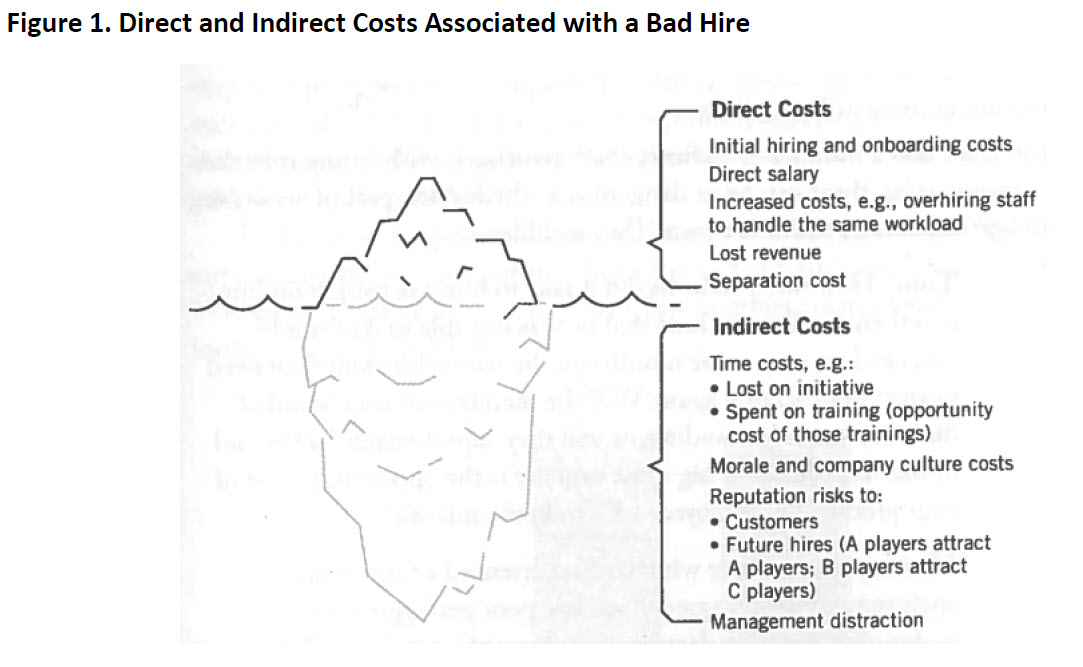Our last blog illustrated the significant and tangible performance lifts associated with top talent). The value of attracting and selecting top talent cannot be undervalued or overlooked, nor can the direct and indirect costs associated with making a bad hire.
Take Apple and Microsoft a few years back. Both companies were attempting to launch new operating systems, which were obviously in competition with one another for new users and market share. Apple launched its system after 2 years of development with the help of 600 engineers, while Microsoft spent 5 years in development and utilized 10,000 engineers, only to retract its product shortly after going to market. Two very different approaches to recruiting and selecting talent, with two very different outcomes and price tags.
Most organizations have no clue what it costs to hire an employee, and if asked, most would significantly under estimate. This mindset at least partially explains the current recruitment phenomenon, where organizations seem willing to abandon all selection steps to simply get warm bodies in the front door. The problem is, this current trend is only exacerbating the current problem, as these low quality hires inevitably fail and have to be replaced again and again. Consequently, not only is there a significant ROI associated with selecting top talent, there is a substantial savings associated with avoiding making poor selection decisions.
According to Atta Tarki (2020), costs associated with a bad hire can be categorized as Direct or Indirect (Figure 1).

Direct costs are fairly obvious, and refer to things like the cost to advertise, interview and onboard the hire, their salary, lost revenues from under performance, and any severance or legal fees associated with having to terminate them. These are the common termination costs that most people think of; however, according to Bradford Smarts’ book Topgrading, these direct costs only reflect about 1/3 of the actual expense associated with a bad hire. The other 2/3 are indirect in nature.
Indirect costs associated with a bad hire can have motivational implications on your staff and clients. There are inherent time costs associated with a bad hire, as they require additional training and support throughout. This wasted time and resources comes at the expense of top performers, who would have turned this same investment into far greater gains. Through our Exit Interviews we have repeatedly found that top performers leave organizations because they see their managers rewarding below average performance with additional time and coaching resources (e.g., “the squeaky wheel gets the grease”) rather than investing in top performers and the overall company culture. Employees are a reflection of your organization, and bad ones obviously don’t give off a desirable impression. In a world with so much choice, one bad experience or perception is all it takes to lose a client or prospect. Overall, it is estimated that the cost of a bad hire is anywhere between 10 – 15X of that employee’s annual salary, which means the impact is heightened among more complex or senior roles.
By using the findings of both blogs, we are able to conduct a conservative case study of the actual costs associated with hiring a top performer while simultaneously avoiding a bad hire:
Average Sales Rep Performance for Sample Company: $1,000,000
Average Sales Rep Salary: $100,000
ROI: $4.5 Million (increase revenue of $3M, while saving a loss of $1.5M in direct/indirect costs)
It is fair to say that people are the most valuable resources of most companies. Unfortunately, this isn’t reflected in many organization’s talent strategies or recruitment philosophies. With so much quantifiable upside associated with hiring top performers, and such incredible cost savings associated with avoiding bad hires, it would be beneficial for companies to implement robust, objective and validated selection processes that maximize the prediction of employee performance and retention. Sadly, this isn’t the case for a lot of companies. However it is never too late, and with 43 years of experience in the talent management space, Self Management Group is your perfect partner for building a recruitment process that reflects the importance your company places on top talent.

